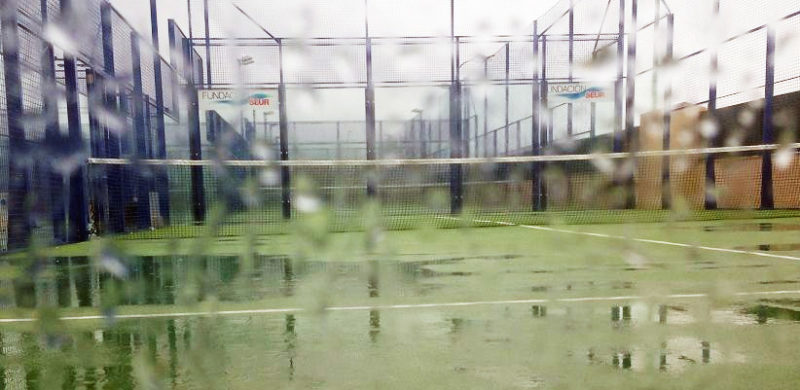As winter approaches, we will have to deal with rain and wet padel courts. It is usually possible to continue playing under light rain conditions, but if a court is soaked then it is better to stop playing or not start in the first place.
Let’s consider a few factors that change drastically when playing in wet weather, and how you can deal with them.
Let’s start with your preparation for the match. Make sure you wear warm clothes, preferably water proof ones. Wearing a cap will prevent rain from coming into your eyes and thus enhance your visibility. If it’s cold apart from rainy, make sure your warmup is longer than usual. Please also ensure you are wearing shoes that have excellent grip, as the surface will be more slippery than under dry conditions and the chances of slips and injury are thus greater.
The ball becomes heavier and loses its bounce when it gets wet. This is the first thing you will have to keep in mind. Given these conditions, it will be much harder to smash the ball and take it out of the court, which in Spanish is called sacarla x3 and sacarla por 4. The same applies for returning the ball to your side of the court after a smash (traerla a tu lado).
With the ball and racket being wet, there will be no grip when you hit the ball. You therefore have to forget about using topspin or underspin/backspin/slice. Use plain shots to make sure you get maximum power transfer and give the ball as much direction as possible under these low grip conditions.
Next, we will have serious problems with the ball bouncing off the walls. Since the walls are also wet, we again have a no grip issue. This will cause the ball to bounce in unnatural ways. Usually a medium to low powered shot will just fall off a wall in a dramatic way, leaving you expecting a ball that never gets anywhere near your racket. The solution to this is to flex your knees even more and prepare your racket lower to be able to catch balls even after irregular rebounds.
If the opponent hits the ball very strongly, you might get a rebound off the wall that is even faster than what you’re used to under dry conditions, and therefore it’s another thing to keep in mind. Using the walls under wet conditions is very tricky, so it might be a better idea to try to avoid walls altogether and play a kind of mini-tennis.
With the walls providing us with little support and lots of menace, it is better to avoid defensive play and always try to stay in the attacking position, close to the net. Try to volley firmly and deep into the opponent’s side to force them into playing off the walls. As we have seen, the walls are very unpredictable and so you will have a much higher chance of the opponent making mistakes. The same applies when serving. Under these conditions, it’s best to serve less balls towards the T and to the feet, and more of them into the corner where the opponent will be forced to play off the wall’s rebound. It will be very hard to return such serves. If you are able to apply some underspin, serving with low power towards the T can also be hard to return as the ball will bounce very low, making it very hard to return.
How about shots where we hit the wall on our side to return ball? This move is called contrapared in Spanish and is quite common in padel. When the walls are wet and the balls that heavy, you need to hit the ball in a softer and more controlled way. If you hit a backwall shot as you normally do in dry conditions the effect will be incredibly exaggerated, so nice and gentle is the way to go.
The so called globo is one of the best shots to use on rainy courts. Remember that it is really essential to position ourselves in the attacking position, since defending on wet courts is a loser’s game. Globos can help us gain the attacking position from our rivals, who will be forced to drop back into defensive positions.
For those of you who can understand Spanish, here’s a good video that explains how to play padel on wet courts:
Of course, if you can avoid playing in wet padel courts, do so even if it means paying a bit extra for indoor courts or covered ones. You will enjoy your games much more in dry conditions. If it rained before you start the match but the sky is now clear, it’s a good idea to dry off the walls so at least you’ll have an off-wall bounce that is similar to dry conditions (the ball will still be wet and affect the bounce). If you can’t avoid playing in wet conditions, then use the above tips to your advantage and gain an edge over your opponents.
Do you regularly play in rainy weather? Do you have any other tips to share?

